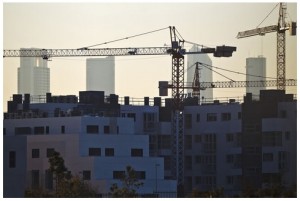Spain Sees Embers Glow in Wreckage of Property Crash
May 28,2014
 Within the ashes left by Spain’s real-estate crash, some embers are glowing.
Within the ashes left by Spain’s real-estate crash, some embers are glowing.
As the recovery in euro-region’s fourth-largest economy extends and its record unemployment subsides, the property market whose slump locked the country into a recession is showing signs of life. While home-price data isn’t yet signaling a turnaround, an increase in sales indicates values may be starting to stabilize.
The market is now safe enough for Stanislas de Bellescize, a 44-year-old computer programmer who recently took the plunge and bought a house two subway stops from the affluent Salamanca district in downtown Madrid. More such decisions would offer Prime Minister Mariano Rajoy the prospect of a further pillar on which to build Spain’s revamped economy after more than half a decade of misery.
“We thought this is the right moment,” said de Bellescize, who has found new work after losing his previous job last year. “There is still room to negotiate prices.”
First-quarter house prices and mortgage approvals for March are due to be published on May 28. Economists surveyed by Bloomberg News forecast the data will show the smallest decline in values since 2010.
Pent-Up Demand
 “A stabilization of prices is on the horizon for 2015,” Jesus Castillo, a Paris-based economist at Natixis, which forecasts declines will slow to an average 2 percent next year from 4 percent this year.
“A stabilization of prices is on the horizon for 2015,” Jesus Castillo, a Paris-based economist at Natixis, which forecasts declines will slow to an average 2 percent next year from 4 percent this year.
The sun shines over a stalled real estate construction site in Arroyomolinos.
Evidence of green shoots in the market are emerging. Spain’s General Council of Notaries said earlier this month that home sales jumped more than 45 percent in the first quarter from a year earlier.
“Pent-up demand from buyers who’d been holding off is now coming to the market,” said Juan Villen, head of mortgage lending at Idealista.com, Spain’s largest property website. “They realize prices won’t fall much further and the economy won’t get any worse.”
Further releases this week, including April retail sales and first-quarter gross domestic product, may show stronger growth as households loosen spending slashed amid the toughest austerity measures in the nation’s democratic history. The GDP data will probably confirm economic expansion accelerated to 0.4 percent from 0.2 percent at the end of 2013.
Boom Legacy
Spanish bonds advanced today on speculation that the European Central Bank will increase economic stimulus next month. The yield on Spain’s 10-year benchmark bond fell 10 basis points to 2.89 percent in Madrid. That compares with a euro era record of 7.75 percent in July 2012, when the country was forced to seek aid from European Union peers.
As buyers re-emerge in certain parts of the country, prices, which have dropped an average of 47 percent since the peak in 2007, are starting to increase in cities such as Barcelona, the second-largest, according to Idealista.
In southern-eastern Valencia, the epicenter of the decade-long construction boom and subsequently among the regions worst hit by the crisis, the local association Fevec says builders are being asked to complete hundreds of unfinished homes which landed on the books of Spain’s bad bank, known as Sareb.
Valencia accounts for close to a fifth of Spain’s 1 million empty homes. Those vacant properties are a legacy of the unbridled building of almost 700,000 houses a year between 1997 and 2006, more than France, Germany and the U.K. combined. Last year, there were 43,600 homes completed in Spain.
Investors Gather
“It’s not only foreigners anymore, we’re actually getting calls from people in Madrid,” said Jesualdo Ros, general secretary of Provia, the builders association in Murcia, south of Valencia. “It’ll take time but residential tourism will eventually help to revive local real-estate demand as well.”
The improvement is already attracting investors such as Blackstone Group LP (BX), Goldman Sachs Group Inc (GS) and Azora Capital SL, which last year bought apartment blocks and social-housing developments from local authorities in Madrid.
Investment in Spain by funds, private-equity firms and other financial-services companies more than doubled to 13.9 billion euros ($19 billion) last year. About 37 percent of that went into real estate assets, according to debt-restructuring firm Irea, which expects the proportion to increase this year.
Economists including Souheir Asba at Societe Generale SA in London expect mortgage lending to start recovering toward the end of the year as banks — which forced Spain to seek a 40 billion-euro bailout in 2012 — finish cleaning up their books.
Pick Up
“It’s quite likely to pick up after the European Central Bank’s asset quality review,” said London-based Asba. “Demand is improving and not yet matched by offer.”
Real estate analyst Fernando Acuna says that lenders reluctant to offer credit remain obstacles to house sales.
“Banks are no longer offering 120 percent mortgages over 40 years,” he said. “Today you need at least 20 percent of the property’s value saved up before you can attempt to buy it.”
His Madrid-based firm, Acuna & Asociados, estimates that 40 percent of unsold housing units will never find buyers due to their undesirable location and because workers earning 1,000 euros a month — known as “mil euristas” — aren’t able to stump up deposits. About 30 percent of workers in Spain earn less than 1,216 euros a month, statistics office data show.
“Real estate is lagging but it’ll follow now that the economy has started to grow,” said Madrid-based Angel Laborda, chief economist at Funcas, Spain’s savings banks’ foundation. “It’s taking much longer, but Spain is going through the same process as the U.S. or Ireland, where construction is contributing to the economy again.”
Source: http://www.bloomberg.com



